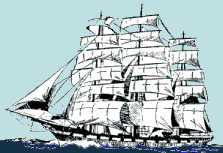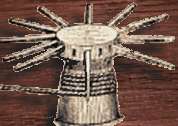Shanty Songs, Shanty MIDI, Listen to Shanties- The Sea Shanty .net
"Shanties may be roughly divided, as regards their use, into two classes: (a) Hauling shanties, and (b) Windlass and Capstan. The former class accompanied the setting of the sails, and the latter the weighing of the anchor, or 'warping her in' to the wharf, etc. Capstan shanties were also used for pumping ship. A few shanties were 'interchangeable,' i.e. they were used for both halliards and capstan."*
Listen to Shanties
These Shanty MIDI files are generously provided by Lesley Nelson Burns and Contemplator.com.

Short-haul (or: short drag, double-pull, sweating up) shanty songs were sung when quicker, strenuous work like trimming the sails, raising the masthead, or pumping required quick, hard pulls. The task and the song were shorter in length than other types.
Examples: "Johnny Boker", "Paddy Doyle", "Haul Away, Joe"
[Listen]
(sheet music) Haul Away, Joe sequenced by Lesley Nelson-Burns
Long-haul (or- long drag, single-pull, halyard) shanty songs were sung during the longer jobs, such as hauling up the yardarms. The Shantyman would sing or line out the verse while the men would rest and perhaps get a better grip. The men would sing the chorus during the long haul of the rope, or halyard. The number of pulls made during the chorus could be between one and three, depending on the weight of the sail.
Examples: "Tom's Gone to Hilo", "Blow the Man Down." "Hanging Johnny"
[Listen]
(sheet music) Hanging Johnny sequenced by Lesley Nelson-Burns
"For 'pull-and-haul' shanty songs, the shantyman took up his position near the workers and announced the shanty, sometimes by singing the first line. This established the tune to which they were to supply the chorus. For capstan shanties he usually did the same. He frequently sat on the capstan, but so far as I can learn he more usually took up his position on or against the knightheads." *
Windlass / Pumping shanties -
1) Windlass shanty songs were sung during the hauling up or "weighing" of the anchor when it was fixed to a horizontally-placed, barrel-shaped tool called the windlass. The song was similar to the short-haul type, because the work required a long cycle of short and hard pulls on either fixed handles or staves which had to be repositioned after every pull.
Examples: "Shenandoah", "Fire down Below",
"Oh, You New York Girls (Can't You Dance the Polka)"
[Listen]
New York Girls sequenced by John Renfro Davis
2) Pumping Shanty songs were sung during the frequent and strenuous work of pumping the water out of the bottom, or bilge of the ship. As most early pumps were two-man types, the action lent itself to the singing of various double-pull (short-haul) shanties.
Examples include: "Stormalong John", "Lowlands", "The Dead Horse"
[Listen]
(sheet music) The Dead Horse sequenced by Lesley Nelson-Burns

Capstan shanty songs were sung during the hours spent walking around the vertically-oriented, round capstan, raising the anchor. The songs are considered the most-developed of the shanties, with a smoother feel, steady, rhythm, and usually a full chorus that complements the verses.
Examples: "Billy Boy", "Rio Grande", "Paddy, Get Back"
[Listen]
Paddy, Get Back sequenced by John Renfro Davis
Stamp-n-Go (walkaway / runaway) shanty songs were sung on ships with larger crews while hauling up the large sails. The men would hold the rope as if in a tug-of-war and stamp out the rhythm while marching along the deck.
Examples: "Roll the Old Chariot", "Drunken Sailor"
[Listen]
(sheet music) Drunken Sailor sequenced by Mark Johnson
Forecastle and Ceremonial shanty songs were sung during the few times of recreation or rest (spent in the crew's quarters of the forecastle), and also special occasions like crossing the equator or entering port.
Examples: "Rolling Down To Old Maui", "High Barbaree", "Leave her, Johnny"
[Listen]
Leave her, Johnny sequenced by Lesley Nelson-Burns
